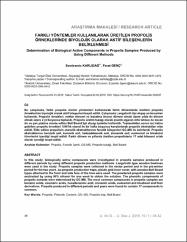| dc.contributor.author | Karlıdağ, Semiramis | |
| dc.contributor.author | Genç, Ferat | |
| dc.date.accessioned | 2021-05-04T09:16:49Z | |
| dc.date.available | 2021-05-04T09:16:49Z | |
| dc.date.issued | 2019 | en_US |
| dc.identifier.citation | Karlıdağ, S. ve Genç, F. (2019). " Farklı yöntemler kullanılarak üretilen propolis örneklerinde biyolojik olarak aktif bileşenlerin belirlenmesi". Uludağ Arıcılık Dergisi, 19(1), 34-42. | en_US |
| dc.identifier.issn | 1303-0248 | |
| dc.identifier.issn | 2687-5594 | |
| dc.identifier.uri | https://doi.org/10.31467/uluaricilik.568297 | |
| dc.identifier.uri | https://hdl.handle.net/20.500.12899/111 | |
| dc.description.abstract | Bu çalışmada, farklı propolis üretim yöntemleri kullanılarak farklı dönemlerde üretilen propolis örneklerinin biyolojik olarak aktif bileşenleri tespit edildi. Çalışmada Langstroth tipi ahşap arı kovanları kullanıldı. Propolis örnekleri, nektar dönemi ve kışlatma öncesi dönem olmak üzere yılda iki dönem olmak üzere 2 yıl boyunca toplandı. Propolis üretim tuzağı olarak plastik ızgaralı örtü tahtası ile kovan ön ve yan yüzüne monte edilen Bell Board tipi ahşap tuzaklar kullanıldı. Toplandıktan sonra toz haline getirilen propolis örnekleri %96’lık etanol ile bir hafta boyunca karıştırılarak propolis ekstraktları elde edildi. Elde edilen propolisin etanolik ekstraktlarının fenolik bileşenleri GC-MS ile belirlendi. Propolis ekstraklarının benzoik asit, kumarik asit, hekzadekanoik asit, sinnamik asit, eudesmol ve bisabolol türevlerini içerdiği tespit edildi. Farklı dönem ve yıllarda üretilen propolislerin 17 adet bileşeni ortak olarak içerdiği tespit edildi. | en_US |
| dc.description.abstract | In this study, biologically active compounds were investigated in propolis samples produced in different periods by using different propolis production methods. Langstroth type wooden beehives were used in the study. Propolis samples were collected in the nectar period and in the pre-winter period for the two years. As propolis production traps, plastic grid inner cover, with wooden Bell Board types attached to the front and side face of the hive were used. The powdered propolis samples were exctracted by using 96% ethanol for one week to obtain the solution. The phenolic components of propolis extracts were determined by GC-MS. The most common compounds in propolis samples are benzoic acids, coumaric acids, hexadecanoic acid, cinnamic acids, eudesmol and bisabolol and their derivatives. Propolis produced in different periods and years were found to contain 17 components in common. | en_US |
| dc.language.iso | tur | en_US |
| dc.publisher | Bursa Uludağ Üniversitesi | en_US |
| dc.relation.isversionof | 10.31467/uluaricilik.568297 | en_US |
| dc.rights | info:eu-repo/semantics/openAccess | en_US |
| dc.subject | Propolis | en_US |
| dc.subject | Fenolik içerik | en_US |
| dc.subject | GS-MS | en_US |
| dc.subject | Propolis tuzağı | en_US |
| dc.subject | Bell board | en_US |
| dc.subject | Phenolic content | en_US |
| dc.subject | Propolis trap | en_US |
| dc.title | Farklı yöntemler kullanılarak üretilen propolis örneklerinde biyolojik olarak aktif bileşenlerin belirlenmesi | en_US |
| dc.title.alternative | Determination of biological active components in propolis samples produced by using different methods | en_US |
| dc.type | article | en_US |
| dc.authorid | 0000-0002-9637-2479 | en_US |
| dc.department | MTÖ Üniversitesi, Akçadağ Meslek Yüksekokulu, Bitkisel ve Hayvansal Üretim Bölümü | en_US |
| dc.contributor.institutionauthor | Karlıdağ, Semiramis | |
| dc.identifier.volume | 19 | en_US |
| dc.identifier.issue | 1 | en_US |
| dc.identifier.startpage | 34 | en_US |
| dc.identifier.endpage | 42 | en_US |
| dc.relation.journal | Uludağ Arıcılık Dergisi = Uludağ Bee Journal | en_US |
| dc.relation.publicationcategory | Makale - Ulusal Hakemli Dergi - Kurum Öğretim Elemanı | en_US |


















